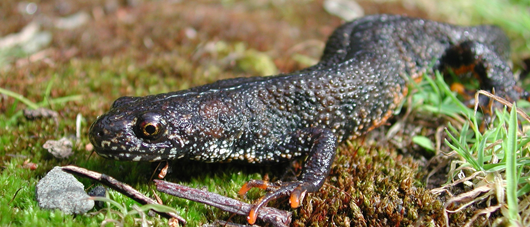Great Crested Newt Surveys in Barnsley Starting from £500.00
Ecological Consultants Providing Great Crested Newt Surveys and Reports throughout Barnsley
JCA Limited are industry-leading Ecological consultants based in Halifax, West Yorkshire operating nationwide throughout the United Kingdom. We offer a range of Ecological surveys for developers, local authorities and smaller private customers undertaken by licensed ecologists.
Great Crested Newts in Barnsley
There are seven native species of amphibian in the UK; three Newts (Great Crested, Palmate and Smooth), two Frogs (Common and Pool) and two Toads (Common and Natterjack). Of these, the Great Crested Newt (Triturus cristatus), Natterjack Toad (Epidalea calamita) and Pool Frog (Pelophylax lessonae) are fully protected under UK law. Of these three protected species, Great Crested Newts (GCNs) are much more widespread and likely to be encountered by developers.
Like all UK amphibians, Great Crested Newts rely on water bodies for breeding, but spend the majority of their lives on land. GCNs enter hibernation around mid-October to November, and emerge around mid-February (depending on local weather conditions). Adults will then seek out suitable water bodies and begin egg laying around mid-March up until around June. After this the adults will adopt a primarily terrestrial lifestyle until the next breeding season begins. Eggs are laid individually wrapped within the leaves of aquatic vegetation, and larvae will remain in the pond over summer, where they will undertake metamorphosis and emerge as adults around August-October.

Great crested newts can be identified by their dark brown or black colour with distinct ‘warty’ like skin. The underbelly is bright orange with black spots. In the spring, males develop an impressive jagged crest along their back and a white ‘flash’ along the tail.
Great Crested Newt Surveys and Reports in Barnsley
Great Crested Newts (GCNs) rely on water bodies for breeding, but spend the majority of their lives on land. Therefore, even if there are no ponds on your proposed development site, there still could be potential for supporting GCNs.
GCN and their habitats are protected under UK law. Here at JCA Limited we have licensed, experienced Great Crested Newt surveyors who can carry out a range of GCN Surveys.
To determine the presence or absence of Great Crested Newts the standard procedure includes four different survey methods; bottle trapping, egg searching, a torch survey and netting. Natural England specifies that a minimum of four survey visits must be made to conclude presumed absence. If Great Crested Newts are present a further two visits are required to establish a population estimate. It may also be necessary to survey other ponds within 250m or 500m (depending on the scale of the project and habitats to be impacted) of the site.
Should any GCN be found during any stage of a development, all work must stop immediately, and Natural England must be contacted. Natural England will provide advice on the best course of action. It must be stated that this is a legal requirement, and that GCN may only be handled by an experienced ecologist holding an appropriate licence.
Fast, professional and cost effective Great Crested Newt Surveys carried out throughout the UK.
Great crested newts are protected under UK and EU law. Here at JCA we have licensed, experienced great crested newt surveyors who can carry out a range of surveys including: HSI, torching, egg searching, bottle trapping and pit fall trapping.
or Call 01422 376335
Habitat Suitability Index (HSI) Survey for Great Crested Newts
The Habitat Suitability Index (HSI) is a system that was developed for assessing a water body’s potential to support breeding Great Crested Newts (GCNs). If your site has potential for Great Crested Newts, i.e. terrestrial and/or aquatic habitat, all ponds within 500m of the site will be assessed for their suitability. This survey can be undertaken at any time of the year.
Great Crested Newt Torching Surveys in Barnsley
The most common and simplest survey method is a night-time torch search during the breeding season, this is generally undertaken between Mid-February to August, and combined with bottle trapping and egg searches.
GCN Bottle Trapping
GCN Bottle Trapping is a reliable method in detecting adults and juveniles and allows accurate identification of the newt species. This involves setting out bottle traps within 2 meters of each other in the correct temperature and weather conditions around the pond before nightfall and returning at dawn to identify, count and release newt species caught.
Environmental DNA (eDNA) Analysis for Great Crested Newts
An alternative to presence/absence surveys is eDNA. Only one survey is required to prove absence, so in some circumstances, it has the potential to reduce the number of surveys needed, and therefore cost. It also allows for the testing of GCN absence from mid-May to late June.
Great Crested Newt Pitfall Trapping and Refugia Searches in Barnsley
Pitfall trapping and refugia searches for Great Crested Newts is a method for capturing newt on land. It involves putting up specialised newt fencing, sinking buckets flush into the ground 5 to 10 metres apart, to capture newts as they go towards their breeding ponds.
Laying carpet tiles down on the ground allows Great Crested Newts to use these as refugia places to rest. Both these survey methods are usually used as a last resort if a site must be clear of all newts before a development project can begin. Trapping depends on weather conditions and the time of year. These methods allow you to record the sex, species and life stages of all newts and amphibians. Newts and amphibians are then released to a receptor site, out of the way of the construction zone.
Mitigation for Great Crested Newts
If it is discovered that any proposed development may impact upon Great Crested Newts (thus leading to an offence being committed) a mitigation plan must be devised and a GCN Mitigation Licence applied for from the relevant government department (i.e. Natural England in England). Gaining a licence will depend on many variables. Mitigation licences ensure that construction work can proceed lawfully and without affecting Great Crested Newts and their terrestrial and aquatic habitats. Avoidance measures and mitigation plans inform planners and developers how to proceed, using written method statements on how work should be carried out. This includes details of newly created ponds and new enhanced landscapes.
Industry Leading Ecological Consultants in Barnsley
If you think you may require a Great Crested Newt survey, please feel free to get in touch with us and one of our Ecological Consultants will be able to assist you. Our dedicated team provide high-quality surveys for both the public and private sector operating throughout the UK and Internationally. Alternatively, please contact us for a free no- obligation quote on 01422 376335 or email info@jcaac.com.
